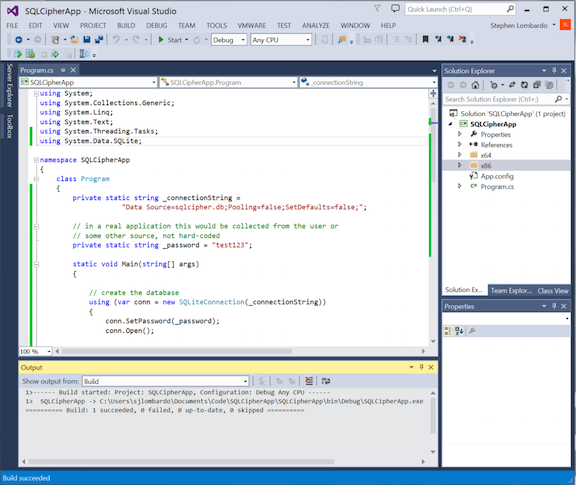

When the user changes the UserPassword then you only need to decrypt the DBdataKey with the old password and re-encrypt it with the new password, but the DBdataKey won't change, so you won't need to re-encrypt the db contents when the user changes its password. Using that (wrong) value to decrypt the HashedSaltedUserPassword will result in more garbage values, which won't match the hash. If the user inputs the wrong password, when you use the DBdataKeyEncryptionKey to decrypt the DBdataKey the decrypt function will give you a different value (garbage). Now use the DBdataKey to decrypt the HashedSaltedUserPassword and compare it with the one you regenerated using the inputed password and the PasswordSalt (which is stored in cleartext) just to double-check that the login information is correct. Now, when the user opens the application, you ask him for the password, then use the inputed password with DBdataKeySalt (which is stored in cleartext) to regenerate the DBdataKeyEncryptionKey, and then use the obtained DBdataKeyEncryptionKey to decrypt the DBdataKey, and so you can use the decrypted DBdataKey to read the DB. That is availabe as a piad option (SEE) from the suppliers of SQLite, or there are other 3rd party. Base SQLite does not include an encryption option. This means that a database encrypted with SQLCipher via DB Browser for SQLite may not be able to be opened in another application, and vice versa - SQLCipher only recognises 256-bit AES, so. Or to be a bit more explicit, without encrypting the database, it is possible to connect to the database by any program that uses SQLite (like the CLI) and bypass any 'program based' protection. Use a hash function like pbkdf2 (or something like SHA2 or better) with UserPassword and PasswordSalt to create HashedSaltedUserPassword, a salted-hashed version of the UserPassword, then use DBdataKey to encrypt HasedSaltedUserPassword before storing it in the DB.įrom now on you can use DBdataKey to encrypt/decrypt the data to/from the DB. There are many third party components that will read/write SQLite databases, but there is no standard encryption method used, if they support encryption. Use a hash function like pbkdf2 (or something like SHA2 or better) with UserPassword and DBdataKeySalt to obtain a DBdataKeyEncryptionKeyĭBdataKey is the key you use to encrypt/decrypt the DB contentsĭBdataKeyEncryptionKey is the key you use to encrypt/decrypt the DBdataKey Store PasswordSalt and DBdataKeySalt in the DB as a clear text. Now you create 2 random salt string: PasswordSalt and DBdataKeySalt. To encrypt/decrypt use one of the many known algorithms, like AES or similar one.
Encrypt sqlite database software#
So the software generate a new random DBdataKey that will be used to encrypt/decrypt the DB contents. Now you have a UserPassword and an empty DB. now output the data to a simple html table.When the user do the first login your software will ask for a new password.
Encrypt sqlite database how to#
"INSERT INTO Dogs (Breed, Name, Age) VALUES ('Golden-Doodle', 'Ellie', 4) ") I am using sql cipher in Qt and i want to encrypt an existing sqlite database.On the Api docs here: this is how to do it: ATTACH DATABASE 'encrypted.db.


"INSERT INTO Dogs (Breed, Name, Age) VALUES ('Husky', 'Glacier', 7) ". $db->exec("INSERT INTO Dogs (Breed, Name, Age) VALUES ('Labrador', 'Tank', 2) ". Using this as an example, what is the best way to encrypt and then decrypt data stored in an sqlite database ? exec("CREATE TABLE Dogs (Id INTEGER PRIMARY KEY, Breed TEXT, Name TEXT, Age INTEGER)")


 0 kommentar(er)
0 kommentar(er)
